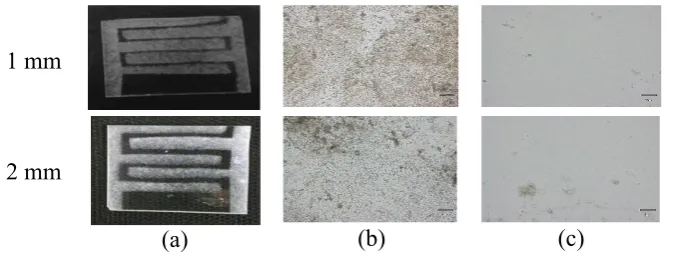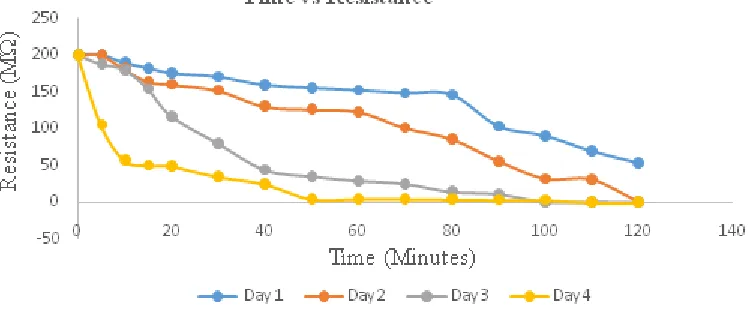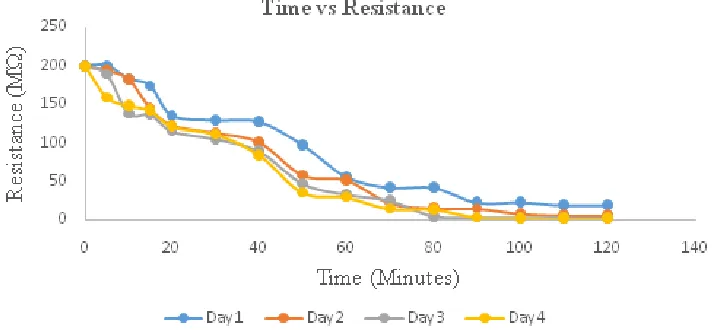The journal homepage www.jpacr.ub.ac.id p-ISSN : 2302 – 4690 | e-ISSN : 2541 – 0733
Effect of Tin Electrode (Sn), Electrode Distance and Thin
Layer Size of Zinc Phthalocyanine (ZnPc) to Resistance
Changes with Ozone Exposure
Agustina Mogi1, Masruroh2, Rachmat Triandi Tjahjanto1*
1
Chemistry Department, Faculty of Mathematics and Natural Sciences, Brawijaya University, Malang, Indonesia
2
Physics Department, Faculty of Mathematics and Natural Sciences, Brawijaya University, Malang, Indonesia
*
Corresponding author email:rachmat_t@ub.ac.id
Received 7 August 2017; Revised 14 December 2017; Accepted 5 January 2018
ABSTRACT
This study was aimed to determine the effect of tin electrode distances and the thickness of a thin layer of ZnPc (Zinc phtyalocyanine) toward changes in resistance with ozone exposure. Tin deposition on the glass surface was conducted using spraying method. The reaction between ozone and ZnPc produces electrical properties that can be read through the resistance value of the multimeter. Based on this study, it was investigated that the smaller a distance between the electrode and the thicker deposition of ZnPc lead to the less resistance. This showed that a thin layer of the conductivity increases along with the longer exposure to ozone gas. The movement of electrons with the hole was free.
Key word: ZnPc (Zinc phtyalocyanine), spraying method, tin electrode, ozone
INTRODUCTION
The ozone molecule contains three oxygen (O3) atoms and is relatively unstable
compared to O2[1]. The ozone in stratosphere is harmless to humans, unless in the
troposphere[2]. Ozone that formed by human activity is very harmful, therefore it is necessary to develop a method or tool to reduce the risk. The choice of sensor method was determined by the ability of the sensor in detecting substances to be detected. The ability of substance detection includes sensitivity, selectivity, response and recovery time, stability, and endurance[3]. The characteristics of ideal sensor are simple operation, low noise, and low production cost, which is the most important aspect[4].
compounds is easier manufacturing which can be operated at the lower temperature and even on the room temperature[6].
The previous research showed that the thin layer of ZnPc deposited on the PCB can be utilized as ozone gas sensor. However, it has short durability due to rapid rusted therefore cannot be stored for a long time[8]. This study was employed tin (Sn) as an electrode. The previous studies have investigated that tin compounds has been utilized to grow SnCl4.5H2O on the surface of the glass using fluorine (F) dopant [9], SnO2
using tantalum (Ta) dopant [10], SnCl4.5H2O using NH4F dopant [11], and SnO2 using
Sb dopant [12]. The technique of tin compound deposition on the glass surface has been conducted using spraying technique. The deposition technique was chosen depends on various aspects such as obtainable and simple handling.
EXPERIMENT
Chemicals and instrumentation
Materials used in this study such as theglass for preparations with a thickness of 1.2 mm, ethanol, ZnPc (Sigma Aldrich, 97%), SnCl2∙5H2O(Riedel-de Haen, 98%),
NH4F (Merck, 98%) and ozone gas.
The equipment used in this study such as digital scales, vacuum evaporator
devices with vacuum pumps (maximum pressure 4x10-4Torr), BX 53 Motorized
Olympus optical microscope and S2X 16 Olympus, Shimadzu 8400S FT-IR Spectrophotometer, HELES UX 37 digital multimeter TR and ozonator that functional in converting free air from the environment into ozone gas. The equipment was self-assembled by the researcher.
Preparation of tin solution
A total of 1.4 grams of SnCl2∙5H2O dissolved in 20 mL of ethanol was added
by0.24 grams of NH4F, the mixture was stirred and sonicated for 20 min. the result was
obtained in a white solution [13].
ZnPc thin layer deposition on glass
Deposition of ZnPc thin layer on aglass was performed by evacuation vacuum method using vacuum evaporator. 0.005 g of ZnPc powder was weighed and placed on ceramic crucible.The distance between glass and ZnPc was maintained 5 cm prior to the deposition and conducted vacuum evaporation for 1 hour. Deposition was undertaken by two time variations of 25 and 45 min using 1 volt voltage.A thin layer of ZnPc coated on the glass was heated (scalded) in an oven at 100°C for 5 hours.
Activity test of changes in ozone sensor resistance
Activity test of the ZnPc layer above the glass was based on a measurement of the electrical properties of the initial ZnPc thin layer resistance value and after the exposure of the ozone gas. Ozone gas was synthesized from oxygen environment using ozonator device. Ozone synthesis was conducted using plasma discharge.
RESULT AND DISCUSSION Tin Electrode Deposition on Glass
The fabrication of glass as a medium of thin layer growth in this study was carried out using Sn(II), which is doped with NH4F, and initiated by making interdigital pattern
variations, such as 1 and 2 mm. Interdigital pattern was printed using aluminum. The glass that has been glued using aluminum is heated at 450oC for 60 minutes to remove unnecessary particle which still attached to the glass surface through evaporation. The process was continued by spraying and heating of Sn(II). This step was repeated until obtained a small resistance which indicates an increase of the conductivity of the glass. To determine the uniformity of Sn(II) deposited on the glass surface, it was necessary to observe the surface morphology using an optical microscope.
1 mm
2 mm
(a) (b) (c)
Figure 1. Deposition of results (a). Electrode pattern (b). Surface electrode (c). Among the electrodes
Observations of surface morphology was indicated that the large-sized grains and electrode growth were not completely similar. This was due to the process of Sn(II) deposition by using spraying equipment produced larger grains and conducted manually. The duration of spraying and the conductivity result can be seen in Table 1.
Table 1.Variation of spraying duration and the resistance result Spraying arranged more homogenously with higher density. The electricity mechanism of SnO that doped using NH4F was expected similar to NiO semiconductors using dopant of
Li2O [14].The replacement of F- ion to O2- position leads to Sn charge around F-
ZnPc Layer Surface Morphology
The morphology of thin layer was determined by the vacuum evaporator method in deposition of the thin layer on glass surface. This method was very beneficial because solid ZnPc without modification can directly be evaporated. It leads to the layer becomes softer, which enables gas absorption optimization.
(a) (b) (c)
Figure 2.Electrode picture after deposition of thin layer : (a) Electrode pattern (b) ZnPc deposition for 25 minutes (c) ZnPc deposition for 45 minutes
The indications of fine layers which are well deposited include the deposition result was homogeneous. It was observed using the microscope which was not easily released. The longer the deposition time leads to the amount of material deposited on the substrate increases which indicated by thicker layer. The thickness of the resulting layer was expected to absorb more ozone gas. To determine the effect of thickness on the ozone absorption, the influence of the exposure duration to resistance were measured.
a
b
Figure 3.Surface morphology after deposition : (a) above tin electrode (b) above the surface of the substrate
Effect of Electrode Distance on Thin Layer Resistance
The effect of the distance toward resistance in this research was investigated by varying the distance between electrodes. The correlation between resistance and distance can be seen in Figure 1 and 2.
Figure 1. The correlation between resistance and exposure time at 1 mm electrode distance with 45 minute deposition time
Figure 2. The correlation between resistance and exposure time at 2 mm electrode distance with 45 minute deposition time
Figure 1 and 2 showed that resistance decreases along with the duration of exposure. The decrease of the resistance value indicates a reaction between ozone and the ZnPc thin layer which depicted in equations 1 and 2.
ZnPc (O ,ZnPc) O ZnPc
O3 3 3 (1)
loader charge
ZnPc) , (O ZnPc
O3 3
(2)
transfer causes ozone to form O3- anion, while the electrons in the ZnPc layer are delocalized. Hence, it was easier to move and generated electric current. The longer the ozone which was exposed to ZnPc, the charge carrier electrons will increase. Thus, the thinner layer becomes conductive faster. This result has been investigated from the decreasing value of resistance, along with longer exposure process time. ZnPc used in this study is one of the examples of p-type semiconductor (electron deficient). According to the earlier study which used PCB as electrodes, the resistance has been decreasing since the first hour of measurement[15]. This occurred because Cu metal in the PCB has higher electric conductivity than Sn.
Effect of ZnPc Layer Coating on Layer Resistance
The effect of thickness on the amount of ozone absorbed was showed in Figure 3 and 4.
Figure 3. The correlation between resistance and ozone exposure time of the ZnPc layer deposited for 25 minutes
Figure 4. The correlation between resistance and ozone exposure time of the ZnPc layer deposited for 45 minutes
ozone afforded the smaller resistance. This result showed that the conductivity was increasing. ZnPc is an example of electron-deficient p-type semiconductor. The deficiency of electron causes the formation of hole, which is described as an acceptor that can receive electron. When ozone is exposed on a substrate surface that has been deposited on thin layer, the ozone functions as a charge carrier (electron excess) will fill the empty space on the thin layer. This electron movement provides electrical current. The increase of the electron transfer may lead to the higher conductivity. This was clearly seen in Figure 4 and 5 which indicated the longer exposition time of ZnPc to ozone gas results in smaller resistance. The figures also showed that ZnPc in deposition time for 45 min leads to decreasing of higher resistance. This is because ZnPc layer thickness has more empty space therefore the movement of electron was freer.
CONCLUSION
The electrode distance applied in this study was very influential on the generated resistance. The smaller of electrode distance leads to lower the resistance and enhance the conductivity. Deposition of thin films with different times afforded the different layer thickness. The thicker of the layer resistance cause decreasing of the ozone absorbed.
ACKNOWLEDGMENT
The author is grateful to the government of Ngada district, East Nusa Tenggara province for giving the scholarship to finish education.
REFERENCES Semicond Process.,2015, 38, 177–183.



